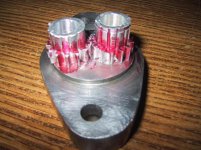Restore49,
To be honest, I'm rather confused and I'd like you to clarify one very important point: is .730" the center-to-center distance between the shafts, or is the outside diameter of the gears? Definitely, it cannot be both.
Likely, the gears aren't metric (i.e. no module), and we would need to talk about diametral pitch.
The good news is that there are two simple formulas for you to use:
DP = (N + 2) / OD
DP = N / PD
Where:
N = number of teeth.
PD - Pitch diameter.
The pitch diameter is the diameter of the circle at which the teeth of both gears mesh at any point during their rotation: the distance between the axes of the two shafts is equal to to the sum of half of the pitch diameter of the two gears. In your case, given that the two gears are identical, the PD is equal to the distance between the axes of the two shafts.
Therefore, if the distance is .730", the DP of your gears is 14/.730 = 19.178 (not very likely).
If the OD of each gear is ~.730", the DP is 16/.730 = 21.92 (~22DP, it would be exactly 22 if the OD is instead .727")
Especially if the gears in your possession are worn, it's much more accurate to calculate the DP using the distance between the axis of the two shafts (which, I believe, should be ~0.636").
Involute gear cutters cut anyhow approximate profile, which is the best compromise for gears of that range of teeth. Not having the correct profile for the teeth translates in not having a proper involute circle, but something more similar to the section of a piece of corrugated tin roofing rolled to form a pipe. The result is that the motion is not transmitted linearly from one shaft to the other, but there are a series of accelerations and decelerations depending upon where is the actual contact between the teeth.
Paolo



